Wenn Sie Ihr WordPress-Administrator-Passwort auf dem lokalen Host vergessen, kann das frustrierend sein. Da die Wiederherstellung von E-Mails in dieser Umgebung möglicherweise nicht funktioniert, müssen Sie andere Wege finden, um wieder Zugang zu erhalten.
Wir empfehlen, WordPress lokal auf Ihrem Computer zu installieren, um die Entwicklung von WordPress zu erlernen oder neue Plugins und Themes zu testen.
Allerdings funktionieren einige Dinge auf localhost nicht wie auf einer echten Website. Dazu gehört die E-Mail-Funktionalität, die Sie zum Zurücksetzen Ihres Passworts benötigen.
In dieser Anleitung zeigen wir Ihnen mehrere einfache Methoden, um Ihr WordPress-Administrator-Passwort auf Localhost zurückzusetzen.
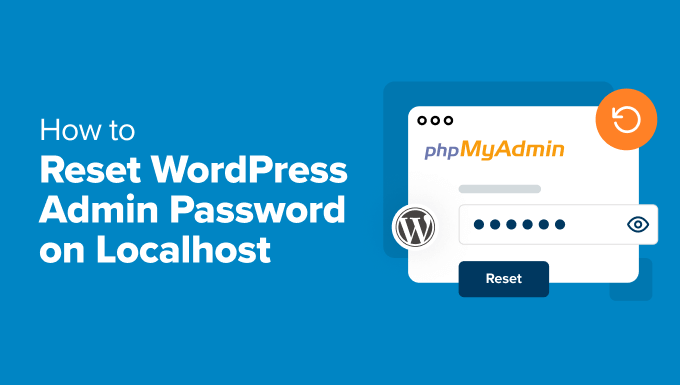
Warum das Zurücksetzen des Passworts auf Localhost nicht funktioniert
Der Begriff localhost bezeichnet einen lokalen Server, der für die Allgemeinheit nicht zugänglich ist, wie z. B. Ihr persönlicher Computer.
Viele Benutzer von WordPress installieren WordPress auf Localhost (auf ihrem Computer), um Änderungen zu testen, Websites zu entwerfen, neue Plugins auszuprobieren und sogar WordPress zu lernen.
Wenn Sie es noch nicht ausprobiert haben, helfen Ihnen die folgenden Anleitungen, WordPress auf Ihrem Computer zu installieren:
Nun gibt es ein Problem, auf das manche Anfänger stoßen könnten.
Wenn Sie Ihr WordPress-Administrator-Passwort vergessen haben, während Sie auf dem Localhost arbeiten, können Sie es nicht mit der normalen Option zum Zurücksetzen des Passworts in WordPress zurücksetzen.
Mit der Option zum Zurücksetzen des Passworts erhalten Sie E-Mails mit einem Link zum Zurücksetzen Ihres WordPress-Passworts. Ihr Server muss die E-Mail-Funktion aktivieren, um E-Mails zu versenden.
Diese Funktion ist jedoch auf lokalen Servern standardmäßig deaktiviert, d. h. WordPress kann keine E-Mails zum Zurücksetzen des Passworts versenden.
Machen Sie sich keine Sorgen. Es gibt einfache Möglichkeiten, Ihr WordPress-Passwort auf dem Localhost zurückzusetzen. Hier sind die Methoden, die wir in diesem Tutorial behandeln werden:
Methode 1. WordPress Admin-Passwort auf Localhost mit phpMyAdmin zurücksetzen
Wir zeigen Ihnen, wie Sie das WordPress-Administrator-Passwort auf dem Localhost mit phpMyAdmin festlegen. phpMyAdmin ist eine webbasierte Anwendung, die eine grafische Benutzeroberfläche für die Verwaltung von MySQL-Datenbanken bietet.
Hinweis: phpMyAdmin ist auf lokalen Servern von Wampserver, XAMPP und MAMP vorinstalliert. Wenn Sie jedoch„Local“ verwenden, finden Sie unter dem Tab „Database“ ein anderes Werkzeug namens Adminer. Es ist dem phpMyAdmin ähnlich und Sie können der Anleitung leicht folgen.
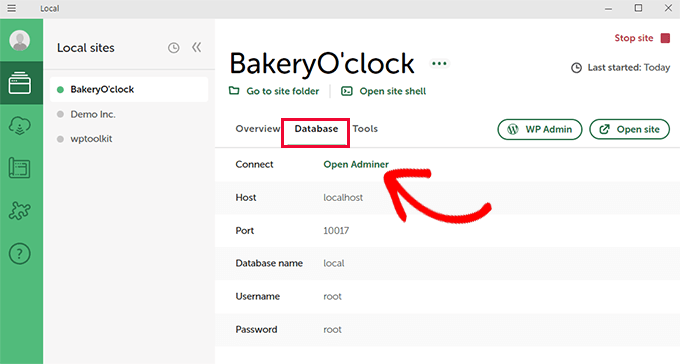
Rufen Sie einfach das phpMyAdmin-Kontrollzentrum auf, indem Sie diese URL in die Adresszeile Ihres Browsers eingeben:
http://localhost/phpmyadmin/
Hinweis: Möglicherweise werden Sie aufgefordert, Ihren Root-Benutzernamen und Ihr Passwort einzugeben, um sich bei phpMyAdmin anmelden zu können. Normalerweise ist der Benutzername root und kein Passwort.
Sobald Sie angemeldet sind, klicken Sie auf Ihre WordPress-Datenbank in der linken Spalte.
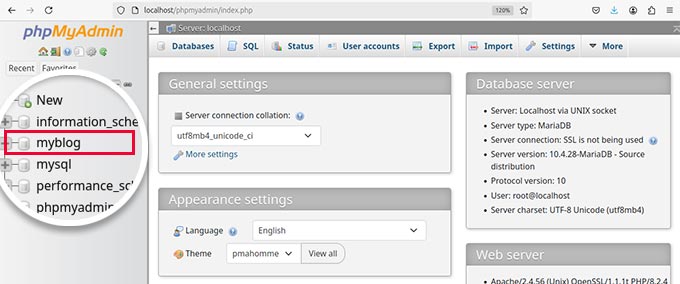
Sobald Sie Ihre Datenbank ausgewählt haben, sehen Sie eine Liste der darin enthaltenen Tabellen.
Klicken Sie auf den Link „Browse“ neben der Tabelle „Benutzer“. Standardmäßig verwendet WordPress wp_ für das Tabellenpräfix, aber wenn Sie es während der Installation geändert haben, wird Ihre Datenbank ein anderes Tabellenpräfix haben.
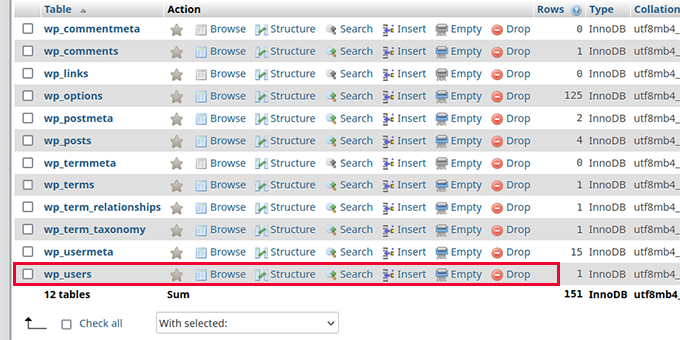
Sie sehen nun die Liste der Einträge in der Tabelle „Benutzer“. Die Anzahl der Zeilen hängt davon ab, wie viele Benutzer auf Ihrer WordPress Website registriert sind.
Als Nächstes müssen Sie auf den Link „Bearbeiten“ neben dem Benutzernamen des Admin-Benutzers klicken.
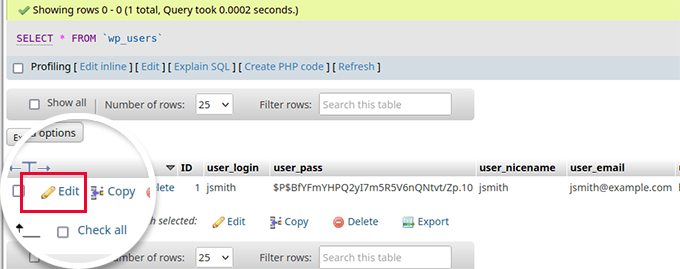
Dadurch öffnet sich ein Formular, das die in Ihrer WordPress-Datenbank gespeicherten Informationen für dieses Konto des Benutzers anzeigt.
Blättern Sie bis zum Feld „user_pass“ und geben Sie in der Spalte „Wert“ ein neues Passwort ein. Wählen Sie dann MD5 in der Spalte „Funktion“.
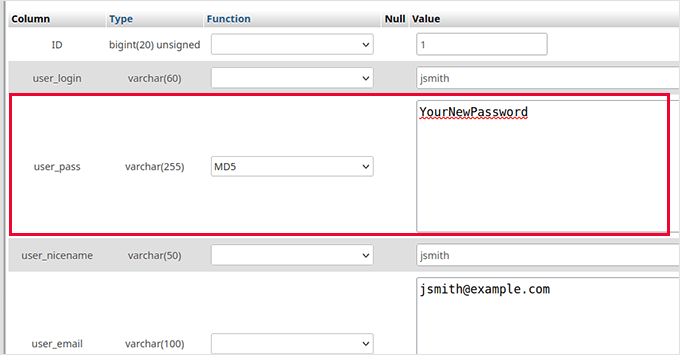
Die MD5-Funktion verschlüsselt Ihr WordPress-Passwort mit dem MD5-Hashing-Algorithmus.
Vergessen Sie nicht, unten auf den Button ‚Go‘ zu klicken, um Ihre Änderungen zu speichern.

Das war’s schon. Mit dem neuen Passwort können Sie sich nun bei Ihrer WordPress Website auf localhost anmelden.
Methode 2: Zurücksetzen des Passworts über die Datei Functions.php
Wenn Sie keinen Zugang zu phpMyAdmin haben oder eine andere Vorgehensweise bevorzugen, können Sie Ihr WordPress-Administrator-Passwort zurücksetzen, indem Sie die Datei functions.php Ihres Themes bearbeiten. Diese Methode ist einfach und kann schnell durchgeführt werden.
Schritt 1: Zugriff auf die Datei Functions.php des Themes
Zunächst müssen Sie die Datei functions.php für Ihr aktives Theme finden. Wechseln Sie dazu in das Stammverzeichnis Ihrer WordPress-Installation auf Ihrem lokalen Rechner.
Je nachdem, welche Software Sie verwenden, kann die Position des Stammverzeichnisses unterschiedlich sein. Wenn Sie z. B. Local verwenden, befindet sich Ihre Website an folgender Position:
C:\Benutzer\Ihr-Benutzername\Lokale Websites\Ihr-Benutzername\Publik\
Wechseln Sie dann in den Ordner /wp-content/themes/. Darin finden Sie einen Ordner, der nach Ihrem aktiven Theme benannt ist.
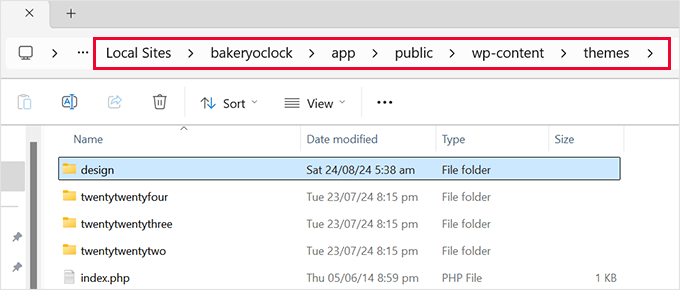
Suchen Sie im Ordner Ihres aktiven Themes nach einer Datei namens functions.php und öffnen Sie sie in einem Texteditor wie Notepad oder TextEdit.
Schritt 2: Hinzufügen des Codes zum Zurücksetzen des Passworts
Am Ende der Datei functions.php müssen Sie den folgenden Code einfügen:
1 2 3 4 5 6 | function reset_admin_password() { $user_id = 1; // ID of the admin user $new_password = 'newpassword123'; // Your new password wp_set_password($new_password, $user_id);}add_action('init', 'reset_admin_password'); |
Vergessen Sie nicht, „newpassword123“ durch ein stärkeres Passwort zu ersetzen, das Sie verwenden möchten.
Mit diesem Code wird ein neues Kennwort für den Benutzer admin mit der ID 1 festgelegt. Wenn Sie die Benutzer-ID nicht kennen, aber die E-Mail-Adresse des Administrators wissen, können Sie stattdessen dieses Codeschnipsel verwenden:
1 2 3 4 5 6 7 8 9 | function reset_admin_password_by_email() { $user_email = 'admin@example.com'; // Admin user's email address $user = get_user_by('email', $user_email); if ($user) { $new_password = 'newpassword123'; // Your new password wp_set_password($new_password, $user->ID); }}add_action('init', 'reset_admin_password_by_email'); |
Dieser Code setzt ein neues Passwort(newpassword123) für den Benutzer admin, der mit der angegebenen E-Mail-Adresse verbunden ist.
Nachdem Sie den Code hinzugefügt haben, speichern Sie die Datei functions.php und aktualisieren Sie die WordPress Website auf Ihrem lokalen Host in Ihrem Browser. Sie sollten nun in der Lage sein, sich mit dem neuen Passwort anzumelden.
Schritt 4: Entfernen des Codes
Nachdem Sie sich erfolgreich angemeldet haben, ist es wichtig, den Codeschnipsel aus der Datei functions.php zu entfernen, um mögliche Sicherheitsrisiken zu vermeiden.
Öffnen Sie einfach die Datei functions.php und löschen Sie den Code, den Sie zuvor hinzugefügt haben. Vergessen Sie nicht, Ihre Änderungen zu speichern.
Bonus Ressourcen:
Im Folgenden finden Sie weitere Tipps und Anleitungen zur Verwaltung von Passwörtern und Administratorkonten in WordPress:
- Hinzufügen eines administrativen Benutzers zur WordPress-Datenbank über MySQL
- Hinzufügen eines administrativen Benutzers in WordPress mit FTP (einfache Anleitung)
- Einfache und sichere Verwaltung von Passwörtern (Anleitung für Anfänger)
- Wie Sie Ihr WordPress Admin (wp-admin) Verzeichnis mit einem Passwort schützen
Wir hoffen, dass dieser Artikel Ihnen geholfen hat, Ihr WordPress-Administrator-Passwort auf einem lokalen Server zurückzusetzen. Vielleicht interessiert Sie auch unser Tutorial zum Aktivieren von WordPress E-Mails von localhost mit SMTP oder ein Blick auf das Erstellen einer Staging Website für WordPress.
Wenn Ihnen dieser Artikel gefallen hat, dann abonnieren Sie bitte unseren YouTube-Kanal für WordPress-Videotutorials. Sie können uns auch auf Twitter und Facebook finden.





Hafiz Muhammad Ansar
Very nice blog for WordPress help. I recommend for beginners to use this platform. Thankful!
WPBeginner Support
Glad you found our article helpful!
Admin
Abdullah
Amazing, it worked
WPBeginner Support
Glad our guide was helpful!
Admin
Nidhi Gupta
it’s really helpful, thankyou so much
WPBeginner Support
Glad our guide was helpful!
Admin
Habu
Omg you save my life !!! THANK YOU VERY MUCHH !!!
Jahir
I can not log in now same process…any updates?
WPBeginner Support
The most common issue would be if you did not set the function to MD5 or click go to apply the changes, you would want to ensure you have done that correctly.
Admin
Kamondo
Wonderful! problem solved. Very Simple steps but powerful.
WPBeginner Support
Glad our guide was helpful
Admin
Joe
I’m encoutering this problem now after installing the 2nd WordPress on MAMP. This article is very to the point and I’ll try it tomorrow!
WPBeginner Support
We hope the guide helps
Admin
Gerron
Solid solid info right here, thanks a lot, really helped, so simple
WPBeginner Support
Glad our guide was helpful
Admin
Odineks
Thank you so much. I always find solutions to every of my WP problems here.
I kept having problems with the login page on the frontend not recognizing my new password, I didn’t realize there is a function to pass that message to myPHPadmin.
WPBeginner Support
Glad our guide was helpful
Admin
naved ahmed
Thanks a lot. Finally problem solved within a minute.
WPBeginner Support
Glad our guide was helpful
Admin
Mohsin
I just love this
Love the way you write every thing
WPBeginner Support
Thank you, glad you like our content
Admin
Jen
I tried this and while I was in there also attempted to change my username, which I realize was probably my mistake… but now I can’t log in at all. Is there a way to undo what I’ve done?
WPBeginner Support
You would need to follow the steps in the article and that would bring you back to where you could edit, you should also be able to use your email as an alternative
Admin
Justina
Your Blog is always so full of rich articles. Thanks so much. was stuck for a while because I skip the MD5 option. You are a lifesaver.
WPBeginner Support
Glad our guide could be helpful
Admin
Sarah
Thank you SO MUCH for this! You saved me so many more hours of tinkering with trying to figure out how to log in!!
WPBeginner Support
Glad we were able to help
Admin
David
Thank you ever so much! Normally, I keep this stuff handy; but in this case, I did could not find where I wrote the information down.
You saved a total re-work of a site I was planning.
WPBeginner Support
Glad our guide could be helpful
Admin
adeel kamran
You saved me, I had a lot of work there.
WPBeginner Support
Glad our guide could help
Admin
lokesh n
thank you it’s really working thank you
WPBeginner Support
You’re welcome glad our article was helpful
Admin
Vivek
Hi,
When I reset My password through link then what fileds affected in Database and in which table.
Kindly share this information i am waiting for your response.
WPBeginner Support
For understanding the database you would want to take a look at our article here: https://www.wpbeginner.com/beginners-guide/beginners-guide-to-wordpress-database-management-with-phpmyadmin/
Admin
Adnan Khan
After half an hour of search i just found my help from this site, which solves my problem in no time,
thanks a lot
keep it up guys
WPBeginner Support
You’re welcome, glad our guides can be helpful
Admin
Tenasu Mensah
thanks a lot, kudos to you guys keep the good work doing,you guys are doing great job
WPBeginner Support
Glad our guide could help
Admin
Anuj
It work fine, Thanku so much,
Pádraig
Really simple and great explanation.
Many thanks for sharing.
Saranya
Works Good! Thanks a lot.
Patr
Hello,
I type a new password , click continue and it does not keep the password, it shows a long string of numbers and letters. If I use this , still cannot log in. It looks simple on the video but does not work for me. Thank you.
I looked everywhere on the internet, no solution worling.
Jason
Same problem here. Did you find a solution? Is there any chance of being hacked?
Christian Gochez
when I click on the Go button this error appears:
#1881 – Operation not allowed when innodb_forced_recovery > 0
Edward
Simple and neat! worked thanks
Handel
I started to just reinstall wordpress, but then decided to do a google search, and there was GOOD OLD RELIABLE WpBeginner.com
Thanks a million!!
Sheriff
very effective… kudos
Icholia
Hello
THANKS, Wow there is no other place that you can get well explained information like this , i have been suffering but now i just followed your tutorial and it is a game changer i love you guys and i will always learn from you guys once again thanks
CJ
Thank you! For those who can’t make it work, remember to use the „MD5“ function when changing the password. I almost skipped that part and was stuck for a few minutes.
mohamad hossein
so use full thank you so much
Janet
I got completely lost on the video so I tried plugging in the URL. Doesn’t work. Still lost.
Ma
Thanks so much, you saved me from what could have been a very embarrassing situation!
James
I change the password, username, userlogin and nickname not I cant login. Any advice?
suganya
i can’t able to login .because it’s shows me like email is not registered .so what can i do???
Jac
Thanks so much for providing this info – I was really stuck!
Gerhard SCHNEIBEL
Thanks a lot for your help. I am very happy with „wpbeginners“.
Renu
it worked.. thanks a ton..
Anthony
Hi…
I am so thankful for such great information you provide. I have bookmarked your site a while back.
I have been working on a site in wordpress using xampp on the Apache local server. Just recently, I am not able to login on the admin page. I have managed to create a user name and password that works on about 95% of all sites requiring me to register. I also created a file that lists all my login info for everywhere I need to login, including the WP admin login page, IF I ever forget that info.
I have read this page (https://www.wpbeginner.com/wp-tutorials/how-to-reset-wordpress-admin-password-on-localhost/) and watched the video, also. The only problem is that when I click on the wp_users in phpMyadmin, I get this error- ‚#1932 – Table ‚bitnami_wordpress.wp_users‘ doesn’t exist in engine.‘
Am I reduced to re-installing WordPress, or is there another way around it?
I have tried restoring my computer (using system restore) to various past restore points, but with no luck. Can you help me with this?
I would be so thankful!!! I have put months of work into designing a site to launch, and I HAVE exported everything to a file quite a few times using WordPress import plugin (something like that).
Could you provide a solution?
Thank you so much…
Anthony
WPBeginner Support
Hi Anthony,
you can also add an admin user by adding code to your current WordPress theme’s admin file.
Admin
Kakaire Charles
Extremely wonderful. Thank you for sharing.
Gaurav
i tried this but not working
shaikh muneer
super way to reset admin password thank you for share this